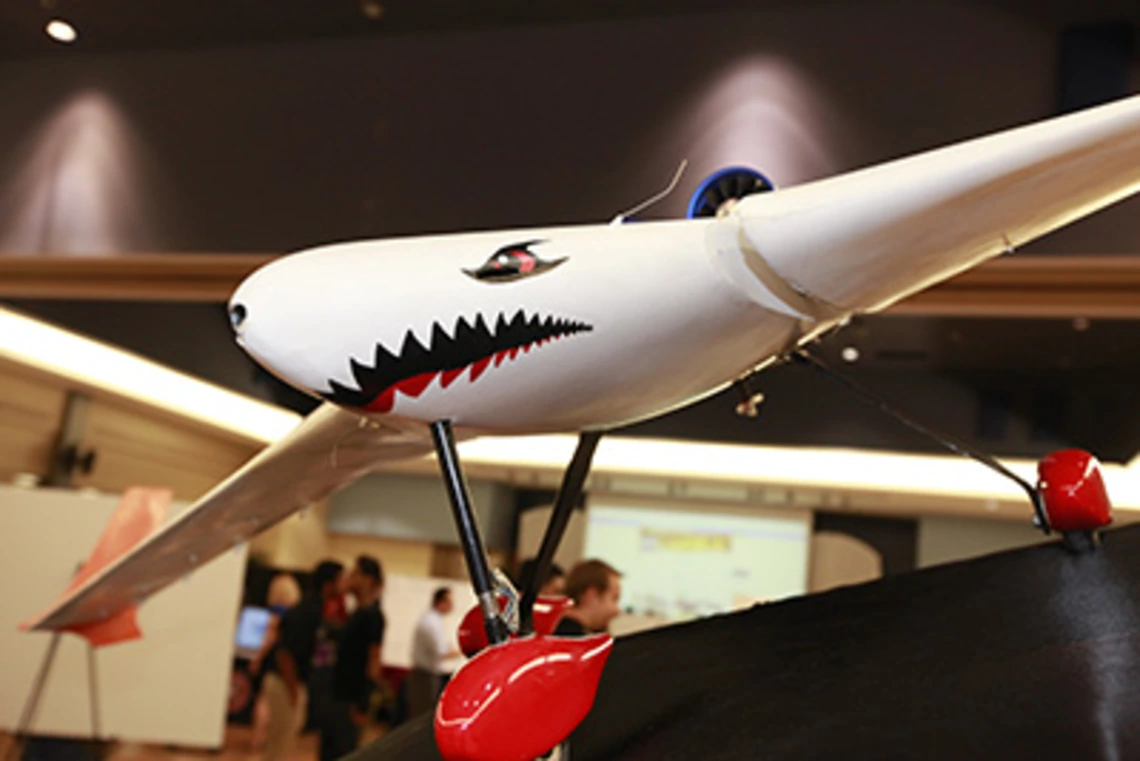Aerospace and Mechanical Engineering Seniors Dominate Design Day Stage

Aerospace engineer Theodore Von Karman once said, "Scientists discover the world that exists; engineers create the world that never was." Everyone who attended the UA College of Engineering’s 13th annual Engineering Design Day this past May would certainly agree. Approximately 400 UA engineering seniors on 77 multidisciplinary teams wowed the crowd with a wide range of projects that showed us pieces of that “world that never was.”
Aerospace engineering seniors were a force to be reckoned with, with four teams winning top awards, while mechanical engineering seniors helped push 17 other interdisciplinary teams into the awards spotlight, attesting to the versatility, strength, and applicability of their skills.
Team 1461, on the project "X-56A DART: Dynamically Scaled Aircraft for Research and Testing," received the CAID Industries Innovation in Manufacturing Award for their design of a modified straight-wing version of Lockheed Martin’s swept-wing X-56 Multi-Utility Technological Testbed for testing flutter suppression and gust alleviation. Professor Hermann Fasel mentored the project, along with AME graduate students Josh Alexander and Jeff Gluck.
Team 1462, who worked on the project “A Method for the Morphing Actuation of Continuous Control Surfaces,” was sponsored by the UA Student Chapter of American Institute of Aeronautics and Astronautics. They took home the Dataforth Corporation Best Design Using a Data Acquisition and Control System Award. Professor Jesse Little mentored the project, which developed a macro fiber composite to actuate control surfaces.
Team 1463, on the project “Sabino Canyon VTOL UAV,” won the Ventana Innovation in Engineering Award for their design of a drone with vertical takeoff and landing capabilities for the purpose of providing surveillance information for Sabino Canyon. Unlike most other senior design projects, this implementation was not modeled after an existing design. Professors Sergey Shkarayev and Anatoli Tumin mentored their work.
Finally, Team 1464, on the project “Dynamic Soaring of UAVs,” was awarded the Bly Family Innovation in Energy Production Award for their development of a simulation that would show that a UAV’s autopilot system may be able to extract energy from a wind gradient to achieve a state of dynamic soaring flight without relying on an electrical or gas energy source. They were mentored by professor Hermann Fasel and grad student Jeffrey Koessler.
Not to be outdone, mechanical engineering seniors shared the spotlight with their interdisciplinary team members for 17 Design Day awards. Indeed, they formed the backbone of over 50 interdisciplinary projects at Design Day, providing valuable input on a mind-boggling array of projects addressing everything from air quality and unmanned aerial vehicles to medical innovations in human and veterinary care.
Notable among the award-winners were Team 1429 on the project “Delivery of an Endovascular Device for a Bifurcating Vascular Anatomy,” who won the PADT Best Use of Prototyping Award. The team was sponsored by professor Jonathan Vande Geest’s Soft Tissue Biomechanics Laboratory for their work in the development of a polymer that can be used to design a flexible, patient-specific device to prevent abdominal aortic aneurysms. Team 1431, on “Air Quality Sensor System,” took the Universal Avionics Best Integration and Test Philosophy Award for the design of system that alerts maintenance to contamination levels within an aircraft cabin during flight. Team 1414, on the project "Advanced Farrier System,” won both the Edmund Optics Perseverance and Recovery Award and the Sargent Aerospace and Defense Voltaire Design Award for their development of a simple, low-cost, user-friendly system for the detection of maladies in horses.
